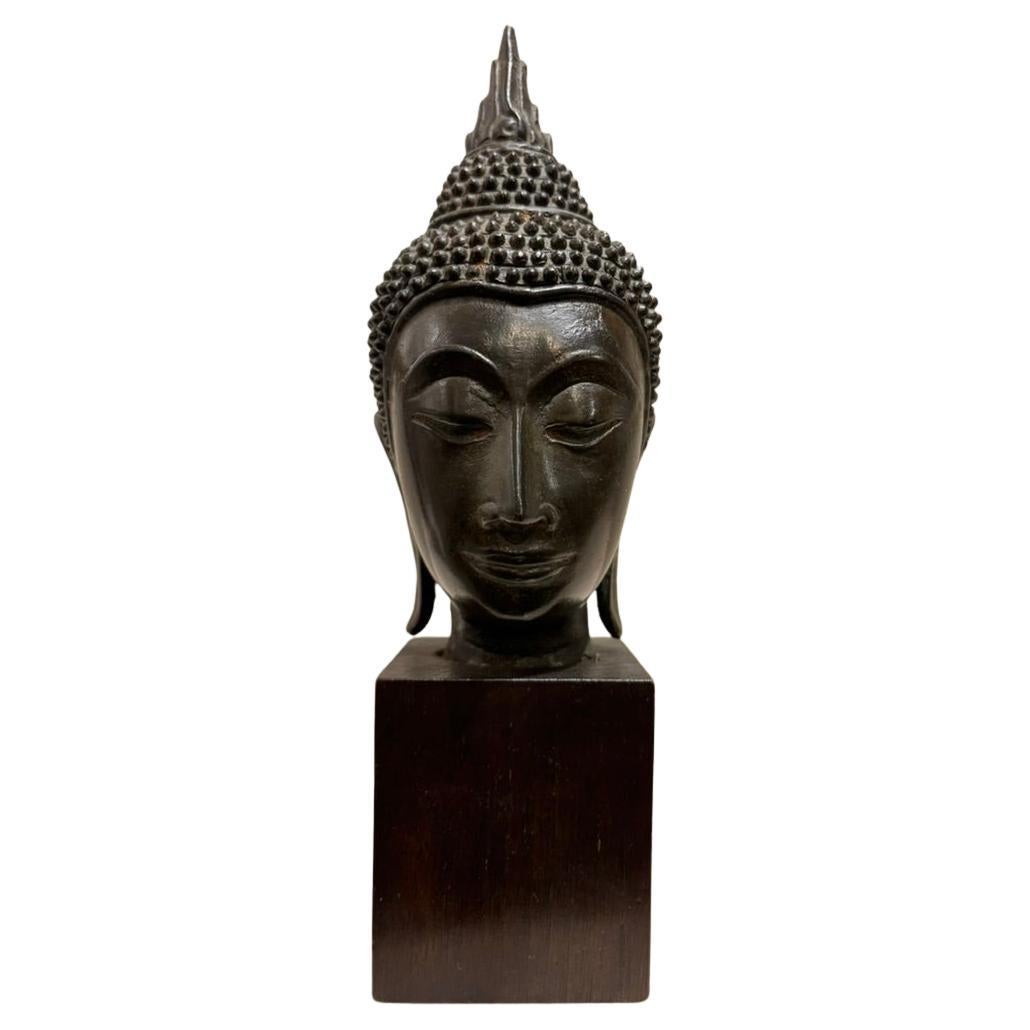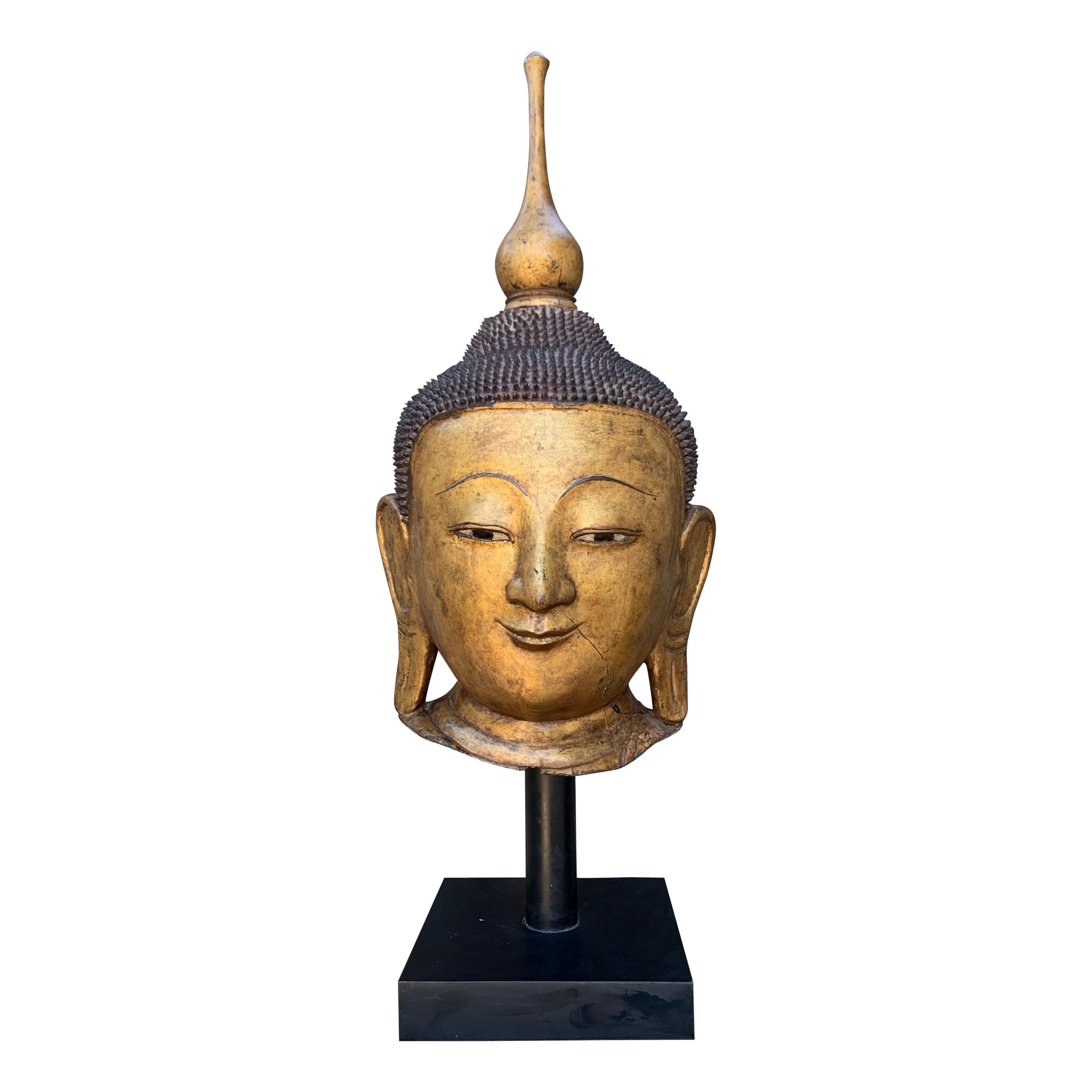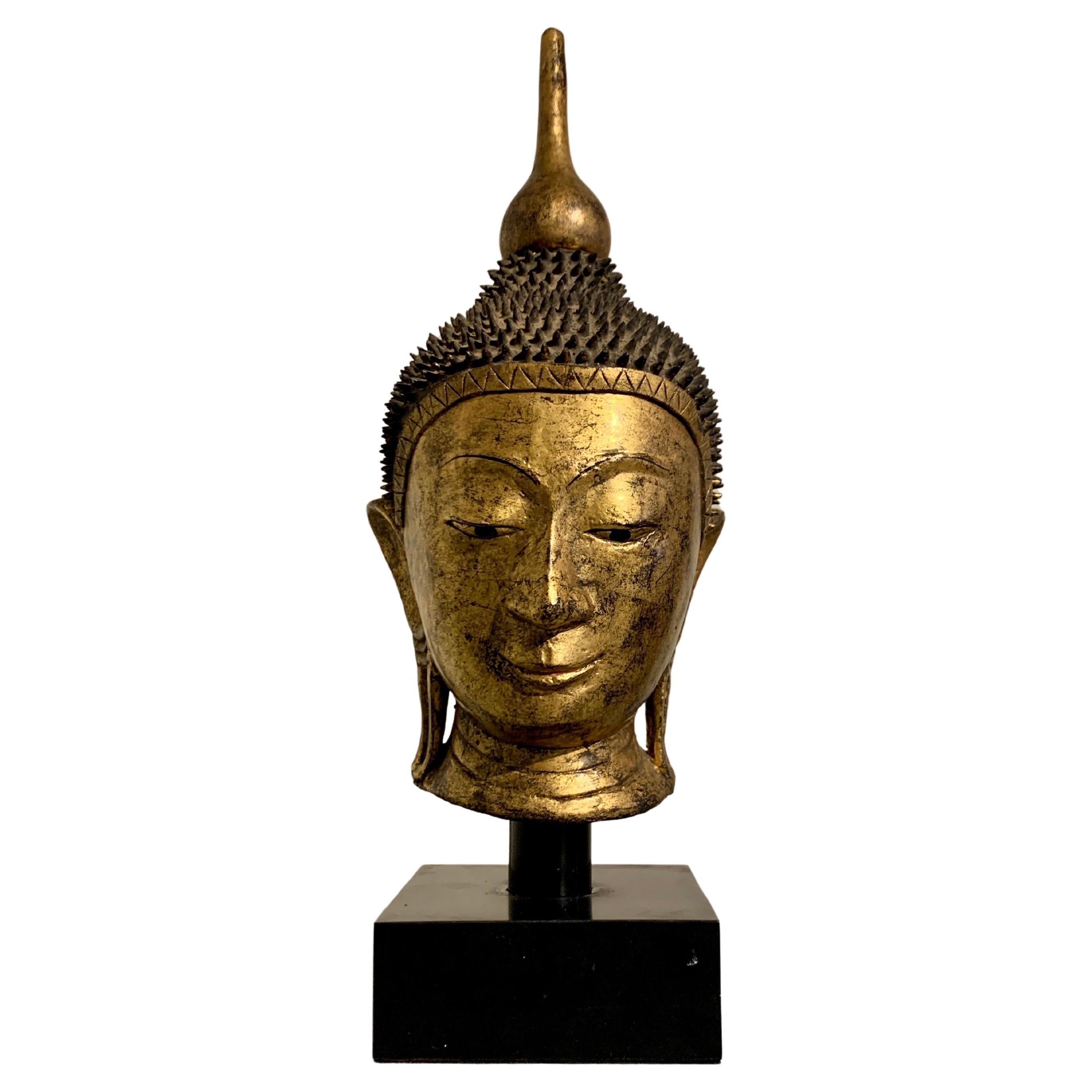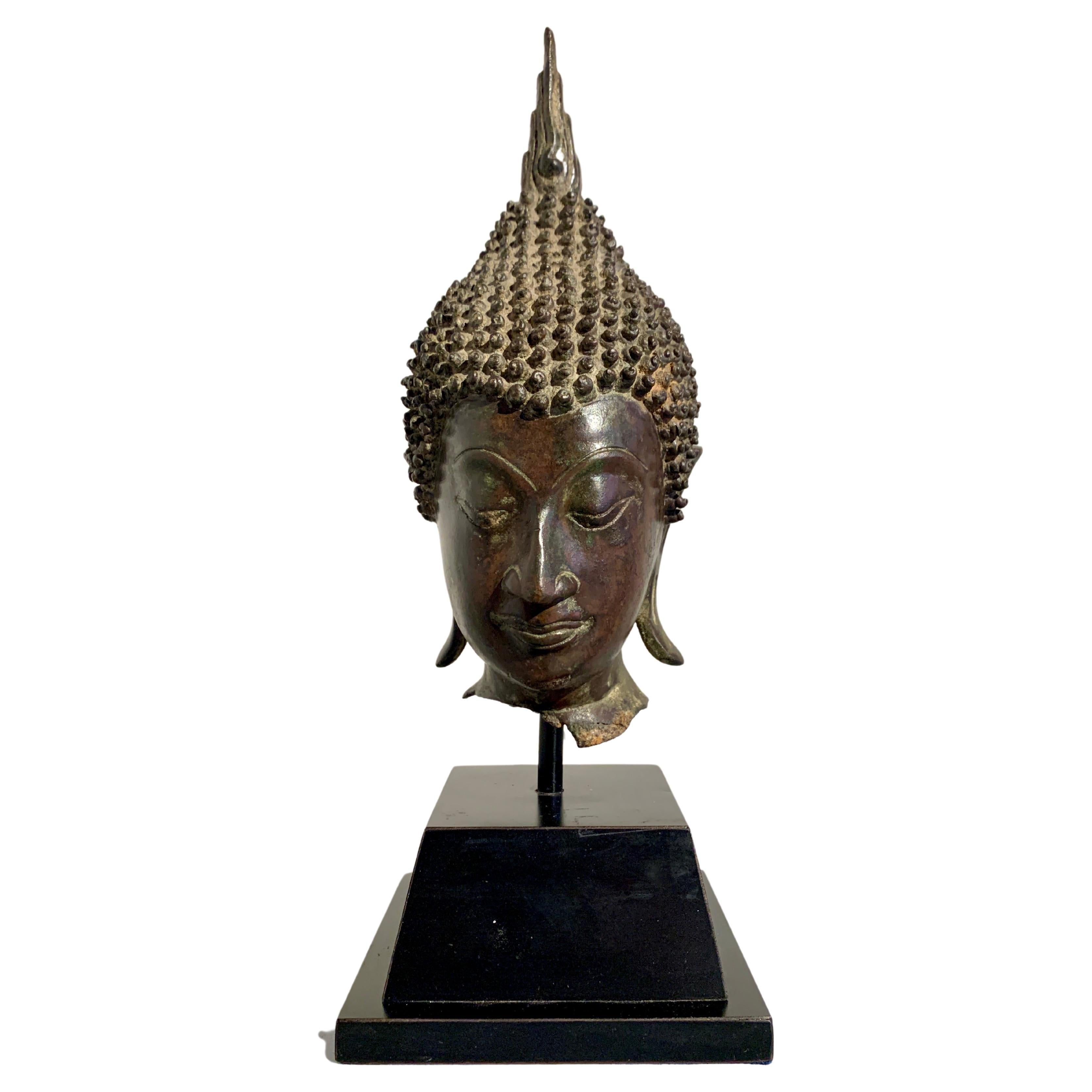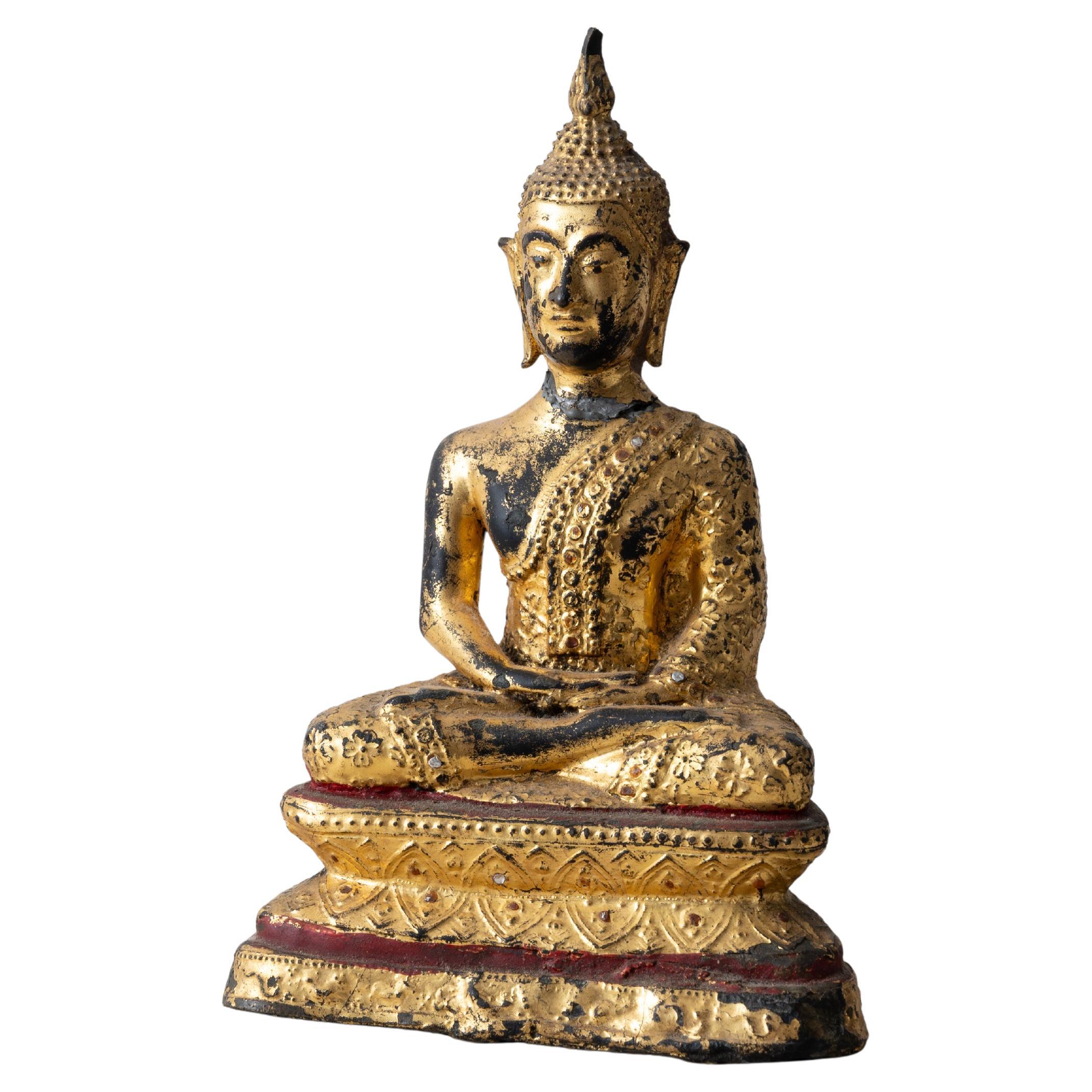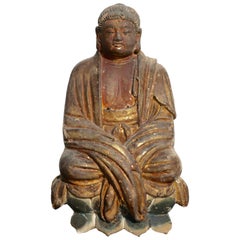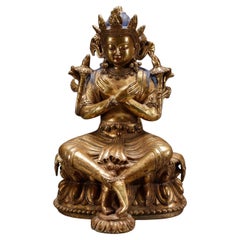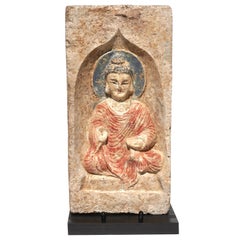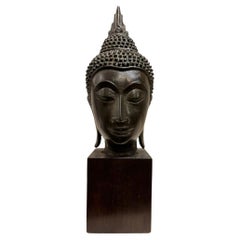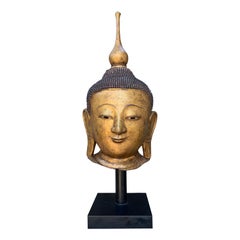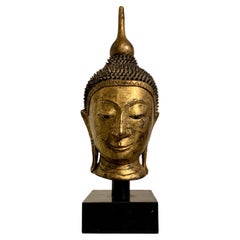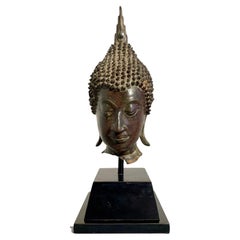Items Similar to Ayutthaya Lacquered And Gilt Bronze Buddha Head 15th Century
Want more images or videos?
Request additional images or videos from the seller
1 of 11
Ayutthaya Lacquered And Gilt Bronze Buddha Head 15th Century
$3,360
$4,20020% Off
£2,509.76
£3,137.2020% Off
€2,909.67
€3,637.0820% Off
CA$4,665.28
CA$5,831.6020% Off
A$5,229.17
A$6,536.4720% Off
CHF 2,722.68
CHF 3,403.3520% Off
MX$63,850.45
MX$79,813.0620% Off
NOK 34,568.11
NOK 43,210.1420% Off
SEK 32,767.46
SEK 40,959.3220% Off
DKK 21,709.26
DKK 27,136.5720% Off
Shipping
Retrieving quote...The 1stDibs Promise:
Authenticity Guarantee,
Money-Back Guarantee,
24-Hour Cancellation
About the Item
Ayutthaya Lacquered and Gilt Copper Bronze Buddha Head
Circa 15th Century
A beautifully lacquered and gilt bronze Buddha head from the Kingdom of Ayutthaya, Thailand, circa 15th century. The Buddha's face has a distinct Khmer influence, with a square face and jaw, broad nose, and long straight lips curled up ever so slightly at the edges, in the beginnings of a knowing smile.
The Buddha stares unflinchingly outwards from almond shaped eyes and slightly arched brows. Small ears with long pierced lobes frame his face. The hair is arranged in neat rows of tight curls or snails, surmounted by a broad ushnisha, and topped by a large flame finial. The head, originally part of a larger sculpture, and now missing much of the back of the head, was originally gilt, with small traces remaining to the flame finial and areas of the face. Overall with a beautiful and complex patina of mottled greens, browns and reds.
BronzeHeight: 7-1/2 inches. Diameter: 3.75 Inches
With carved fitted wood stand: 10.3 Inches
Condition: Ancient with losses and wear commensurate of age and use.
AVANTIQUES is dedicated to providing an exclusive curated collection of Fine Arts, Paintings, Bronzes, Asian treasures, Art Glass and Antiques. Our inventory represents time-tested investment quality items with everlasting decorative beauty. We look forward to your business and appreciate any reasonable offers. All of our curated items are vetted and guaranteed authentic and as described. Avantiques only deals in original antiques and never reproductions. We stand behind our treasures with a full money back return policy if the items are not as described.
The Historic City of Ayutthaya, founded in 1350, was the second capital of the Siamese Kingdom. It flourished from the 14th to the 18th centuries, during which time it grew to be one of the world’s largest and most cosmopolitan urban areas and a center of global diplomacy and commerce. Ayutthaya was strategically located on an island surrounded by three rivers connecting the city to the sea. This site was chosen because it was located above the tidal bore of the Gulf of Siam as it existed at that time, thus preventing attack of the city by the sea-going warships of other nations. The location also helped to protect the city from seasonal flooding.
The city was attacked and razed by the Burmese army in 1767 who burned the city to the ground and forced the inhabitants to abandon the city. The city was never rebuilt in the same location and remains known today as an extensive archaeological site.
At present, it is located in Phra Nakhon Si Ayutthaya District, Phra Nakhon Si Ayutthaya Province. The total area of the World Heritage property is 289 ha.
Once an important center of global diplomacy and commerce, Ayutthaya is now an archaeological ruin, characterized by the remains of tall prang (reliquary towers) and Buddhist monasteries of monumental proportions, which give an idea of the city’s past size and the splendor of its architecture.
Well-known from contemporary sources and maps, Ayutthaya was laid out according to a systematic and rigid city planning grid, consisting of roads, canals, and moats around all the principal structures. The scheme took maximum advantage of the city’s position in the midst of three rivers and had a hydraulic system for water management which was technologically extremely advanced and unique in the world.
The city was ideally situated at the head of the Gulf of Siam, equi-distant between India and China and well upstream to be protected from Arab and European powers who were expanding their influence in the region even as Ayutthaya was itself consolidating and extending its own power to fill the vacuum left by the fall of Angkor. As a result, Ayutthaya became a center of economics and trade at the regional and global levels, and an important connecting point between the East and the West. The Royal Court of Ayutthaya exchanged ambassadors far and wide, including with the French Court at Versailles and the Mughal Court in Delhi, as well as with imperial courts of Japan and China. Foreigners served in the employ of the government and also lived in the city as private individuals. Downstream from the Ayutthaya Royal Palace there were enclaves of foreign traders and missionaries, each building in their own architectural style. Foreign influences were many in the city and can still be seen in the surviving art and in the architectural ruins.
The Ayutthaya school of art showcases the ingenuity and the creativity of the Ayutthaya civilization as well as its ability to assimilate a multitude of foreign influences. The large palaces and the Buddhist monasteries constructed in the capital, for example at Wat Mahathat and Wat Phra Si Sanphet, are testimony to both the economic vitality and technological prowess of their builders, as well as to the appeal of the intellectual tradition they embodied. All buildings were elegantly decorated with the highest quality of crafts and mural paintings, which consisted of an eclectic mixture of traditional styles surviving from Sukhothai, inherited from Angkor, and borrowed from the 17th and 18th century art styles of Japan, China, India, Persia and Europe, creating a rich and unique expression of a cosmopolitan culture and laying the foundation for the fusion of styles of art and architecture popular throughout the succeeding Rattanakosin Era and onwards.
Indeed, when the capital of the restored kingdom was moved downstream and a new city built at Bangkok, there was a conscious attempt to recreate the urban template and architectural form of Ayutthaya. Many of the surviving architects and builders from Ayutthaya were brought in to work on building the new capital. This pattern of urban replication is in keeping with the urban planning concept in which cities of the world consciously try to emulate the perfection of the mythical city of Ayodhaya. In Thai, the official name for the new capital at Bangkok retains “Ayutthaya” as part of its formal title.
- Dimensions:Height: 7.75 in (19.69 cm)Diameter: 3.75 in (9.53 cm)
- Style:Ming (Of the Period)
- Materials and Techniques:
- Place of Origin:
- Period:
- Date of Manufacture:1500
- Condition:Wear consistent with age and use.
- Seller Location:Dallas, TX
- Reference Number:1stDibs: LU1774227578742
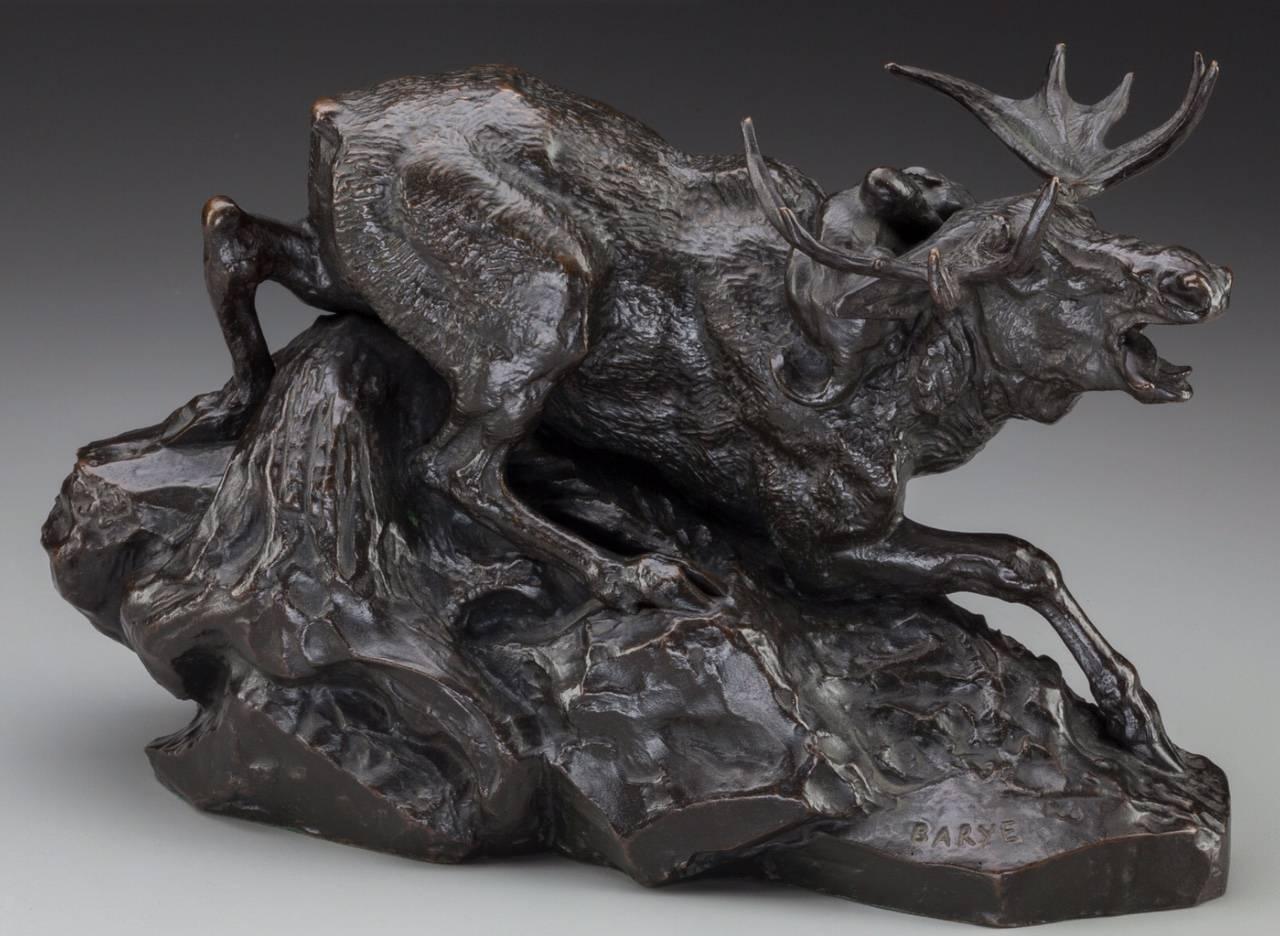
About the Seller
4.9
Gold Seller
Premium sellers maintaining a 4.3+ rating and 24-hour response times
Established in 2000
1stDibs seller since 2015
444 sales on 1stDibs
Typical response time: 8 hours
- ShippingRetrieving quote...Shipping from: Dallas, TX
- Return Policy
Authenticity Guarantee
In the unlikely event there’s an issue with an item’s authenticity, contact us within 1 year for a full refund. DetailsMoney-Back Guarantee
If your item is not as described, is damaged in transit, or does not arrive, contact us within 7 days for a full refund. Details24-Hour Cancellation
You have a 24-hour grace period in which to reconsider your purchase, with no questions asked.Vetted Professional Sellers
Our world-class sellers must adhere to strict standards for service and quality, maintaining the integrity of our listings.Price-Match Guarantee
If you find that a seller listed the same item for a lower price elsewhere, we’ll match it.Trusted Global Delivery
Our best-in-class carrier network provides specialized shipping options worldwide, including custom delivery.More From This Seller
View AllEarly Ming Dynasty Chinese Buddha Statue, circa 14th Century
Located in Dallas, TX
A very fine late Yuan to early Ming Chinese terracotta gilt and polychrome painted Buddha figure, he is dressed in thick robes, his hair arranged in ty...
Category
Antique 15th Century and Earlier Chinese Ming Figurative Sculptures
Materials
Terracotta
$4,320 Sale Price
20% Off
Song to Ming Dynasty Cast Iron Daoist Buddhist Head
Located in Dallas, TX
Daoist sage, official, or possibly a Buddhist acolyte.
A large, thick and heavy cast iron statue of a head. Custom vintage carved hardwood stand finishes off this outstanding and decorative bust, circa 10th...
Category
Antique 15th Century and Earlier Chinese Ming Busts
Materials
Iron
$5,760 Sale Price
36% Off
18th C. Tibetan Gilt Bronze Green Tara Buddha Statue
Located in Dallas, TX
A Gilt Bronze Tibetan Representation Of A rare Green Tara Buddha Statue. Sounds like there is an item sealed inside.
Gilt Bronze and Copper.
Early 1...
Category
Antique 1790s Tibetan Tibetan Figurative Sculptures
Materials
Bronze
$2,720 Sale Price
20% Off
Northern Wei Dynasty Terracotta Sculpture of Buddha 386-534 AD
Located in Dallas, TX
C. 386-534 AD. Chinese Northern Wei Dynasty.
A interim Han-Tang Dynasty terracotta brick in a cream-coloured fabric featuring a beautiful depict...
Category
Antique 15th Century and Earlier Chinese Han Figurative Sculptures
Materials
Terracotta
$2,640 Sale Price
30% Off
Northern Wei Dynasty Terracotta Sculpture Of A Seated Buddha 386-534 AD
Located in Dallas, TX
C. 386-534 AD. Chinese Northern Wei Dynasty.
A pre Tang Dynasty terracotta brick in a cream-coloured fabric featuring a beautiful depiction of a...
Category
Antique 15th Century and Earlier Chinese Han Figurative Sculptures
Materials
Terracotta
$2,560 Sale Price
30% Off
Chinese Qing Dynasty Wood Sculpture
Located in Dallas, TX
18th/19th Century Chinese Wood Sculpture Of A Emperor or General. Retains Some Polychrome Decoration And Horsehair Beard, Male Figure Seated On ...
Category
Antique Late 18th Century Chinese Qing Figurative Sculptures
Materials
Wood
$2,640 Sale Price
20% Off
You May Also Like
17th Century Thai Lacquered Bronze Head Of The Buddha
Located in Stamford, CT
A Thai bronze head of Buddha, Ayutthaya period, late 16th-early 17th century. The serene face flanked by long ear lobes slightly flared at the tips, the eyes downcast beneath smooth...
Category
Antique Early 17th Century Thai Other Busts
Materials
Bronze
Monumental Shan Burmese Gilt Lacquer Buddha Head, Early 20th Century
Located in Austin, TX
A Burmese gilt dry lacquer monumental head of the Buddha, Shan States, Myanmar (Burma), early 20th century.
This monumental dry lacquer and gilt head ...
Category
Early 20th Century Burmese Sculptures and Carvings
Materials
Shell, Lacquer
Vintage Shan Burmese Style Gilt Dry Lacquer Buddha Head, circa 1960s, Thailand
Located in Austin, TX
A serene vintage Buddha head of gilt dry lacquer in the Shan Burmese style, but made in Thailand for the export market, circa 1960s, mounted on a b...
Category
Vintage 1960s Thai Sculptures and Carvings
Materials
Laminate, Lacquer
Thai Sukhothai Cast Bronze Buddha Head, 15th/16th Century, Thailand
Located in Austin, TX
An exquisite Thai cast bronze Buddha head, Sukhothai kingdom, circa 15th century, Thailand.
The Buddha's pleasing face, with its narrow, oval ...
Category
Antique 15th Century and Earlier Thai Sculptures and Carvings
Materials
Bronze
A Diminutive Gilt Copper Alloy Head of a Crowned Buddha, Ayutthaya Period
Located in Ottawa, Ontario
This 17th century Ayutthaya Period copper alloy (bronze) head of Buddha depicted in the ‘Phra Chao Song Khruang’ manner (Lord Wearing Ornaments), showing Buddha adorned with an ornat...
Category
Antique 17th Century Thai Other Sculptures and Carvings
Materials
Bronze, Gold Leaf
Thai Gilt Bronze Buddha, 19th Century
Located in Savannah, GA
A Thai gilt bronze seated buddha, 19th Century.
4 ½ inches wide by 2 ½ inches deep by 7 inches tall
Category
Antique 19th Century Sculptures and Carvings
Materials
Bronze
More Ways To Browse
15th Century Bronze
Buddha Head
Thailand Head
Snail Object
18th Century Bronze China
15th Century India
Bronze Sculpture 17th Century
Ming Bronze
Arab Bronze
Carved Gilt Wood Finial
Wood Sculpture Tower
Glass Buddha
Large Thai Sculpture
India Painting 18th Century
17th Century Japanese Paintings
Chinese Court Paintings
Gold Buddhas
Treasure Map
